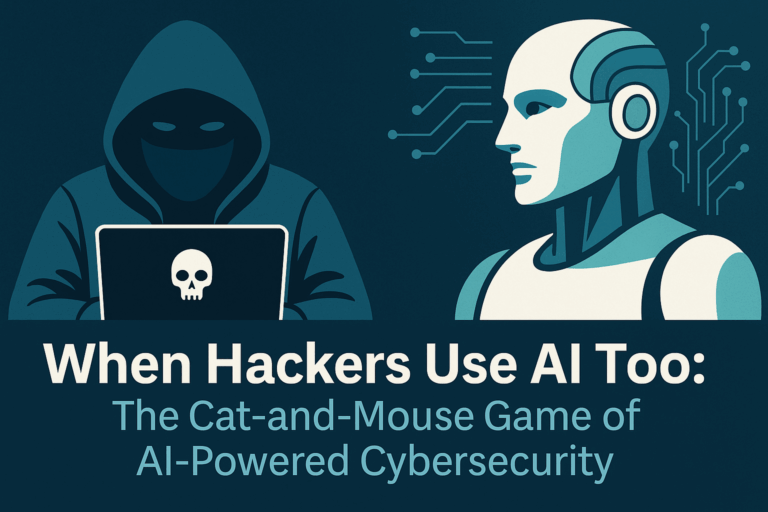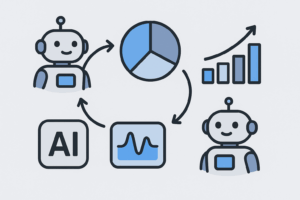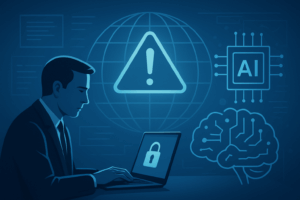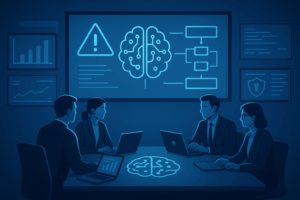The Rise of AI on Both Sides of the Cyber Battle
Artificial intelligence is rapidly transforming the cybersecurity landscape—for both defenders and attackers.
Recent research has uncovered compelling evidence that malicious actors are now leveraging AI to craft sophisticated, evasive attacks. From deepfake scams to adaptive malware, hackers are increasingly using AI to bypass the very tools designed to detect and stop them.
This growing trend is fueling a high-stakes game of cat and mouse, where both sides are constantly evolving their tactics, tools, and techniques.
How Hackers Are Using AI
Cybercriminals have moved well beyond traditional phishing kits and off-the-shelf malware. They’re now tapping into advanced AI techniques, including:
- Generative AI: Used to create phishing emails that are grammatically flawless and hyper-personalized. For example, in 2023, attackers used AI-generated deepfake audio to impersonate a CEO—successfully tricking an employee into transferring $243,000.
- Reinforcement learning: Hackers train AI models to test malicious payloads against common security tools, enabling them to fine-tune evasion techniques before launching an attack.
- Polymorphic malware: Powered by machine learning, this type of malware can continuously alter its code to evade signature-based detection mechanisms.
According to IBM’s 2024 X-Force report, 60% of phishing emails now contain AI-generated content, up from just 20% in 2022. This explosive growth makes phishing faster, more targeted, and significantly harder to detect—especially for security tools relying on static rules or outdated threat intelligence.
How Defenders Are Fighting Back
Fortunately, security teams are also embracing AI to level the playing field. By deploying advanced machine learning techniques and automation, defenders can:
- Detect threats based on behavior: Unsupervised machine learning helps identify anomalies in network traffic or user activity—flagging suspicious behavior rather than relying on known attack signatures.
- Enrich threat intelligence: Platforms like Darktrace and Splunk use AI to analyze millions of signals in real-time, connecting dots across systems to uncover emerging threats.
- Automate response: Security Orchestration, Automation, and Response (SOAR) platforms—such as Palo Alto Networks’ Cortex XSOAR—can contain, isolate, or neutralize threats within seconds of detection.
While these tools dramatically improve response times, they’re not foolproof. Defenders must remain proactive and continuously fine-tune their systems to adapt to evolving attack patterns.
The Cybersecurity Arms Race
As both attackers and defenders embrace AI, we are witnessing a full-scale cybersecurity arms race.
For every leap in detection—like AI models identifying zero-day exploits—there’s an adversary developing new evasion tactics, such as obfuscated code or AI-generated camouflage techniques. It’s no longer sufficient to install antivirus software or rely on monthly patches. Today’s threat landscape is dynamic, and attacks evolve in real time.
Organizations must be equally agile, continuously testing, tuning, and improving their cyber defenses.
What It Means for Businesses and End Users
Whether you’re a CISO managing enterprise risk or a remote employee using cloud apps daily, this new AI-powered threat environment impacts you directly. Here’s what you need to keep in mind:
- Vigilance is non-negotiable: Even with the best tools, a culture of security awareness—fostered through regular training and phishing simulations—is essential.
- AI isn’t a silver bullet: While powerful, AI tools are not immune to flaws, false positives, or hallucinations. Human oversight and domain expertise remain critical.
- Layered defense is critical: Implementing a zero-trust architecture—alongside AI-powered detection, firewalls, encryption, and user access controls—helps eliminate single points of failure.
Final Thoughts
As AI empowers both hackers and defenders, the cybersecurity landscape becomes more complex—and more urgent.
This is not a hypothetical future. It’s happening right now. With over half of phishing emails already leveraging AI-generated content, the threat is active and growing. The most resilient organizations will be those that blend cutting-edge AI tools with human insight, layered security, and a security-first mindset.
AI is both part of the problem and a cornerstone of the solution.
Stay informed. Stay updated. Stay secure.




